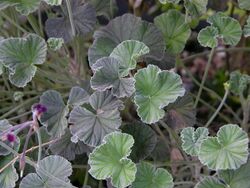Biology:Pelargonium sidoides
| Pelargonium sidoides | |
|---|---|

| |
| Scientific classification | |
| Kingdom: | Plantae |
| Clade: | Tracheophytes |
| Clade: | Angiosperms |
| Clade: | Eudicots |
| Clade: | Rosids |
| Order: | Geraniales |
| Family: | Geraniaceae |
| Genus: | Pelargonium |
| Species: | P. sidoides
|
| Binomial name | |
| Pelargonium sidoides DC.
| |
Pelargonium sidoides is a plant native to South Africa , Eswatini, and Lesotho. Its common names include African geranium and South African geranium. The current conservation status is Least concern.[1]
Description
African geranium forms a basal rosette of cordate leaves with a velvet texture and a few short trichomes on long petioles.[2] Its flowers have five dark red to nearly black petals, two of which are sometimes fused. It is often found in flower nearly year-round. It prefers to grow in grasslands with rocky soils. It can be difficult to distinguish from Pelargonium reniforme which grows in a similar area, but tends to have more kidney-shaped leaves.
Uses
In cultivation in the UK, Pelargonium sidoides has received the Royal Horticultural Society's Award of Garden Merit.[3] If grown as a perennial it requires protection in winter, as it does not tolerate temperatures below 5 °C (41 °F). It needs a sunny, sheltered position.
A 2013 Cochrane review found limited to no evidence of benefit with Pelargonium sidoides root extract for the symptoms of acute bronchitis, the common cold and acute rhinosinusitis.[4] A summary of this review found that all studies were "from the same investigator (the manufacturer) and performed in the same region (Ukraine and Russia)."[4]
Root extract of Pelargonium sidoides may be sold as a dietary supplement or traditional medicine under various brand names, including Umckaloabo and Zucol, but there is limited high-quality clinical evidence it provides any benefit.[5]
References
- ↑ "Redlist article about the Pelargonium sidoides". https://www.iucnredlist.org/species/219273119/219273122.
- ↑ Lis-Balchin, Maria (2003). Geranium and Pelargonium: History of Nomenclature, Usage and Cultivation. Boca Raton, Florida: CRC. ISBN 978-0-203-21653-8.[page needed]
- ↑ "Pelargonium sidoides". Royal Horticultural Society. https://www.rhs.org.uk/Plants/27782/Pelargonium-sidoides/Details.
- ↑ 4.0 4.1 Timmer, Antje; Günther, Judith; Motschall, Edith; Rücker, Gerta; Antes, Gerd; Kern, Winfried V (2013). "Pelargonium sidoides extract for treating acute respiratory tract infections". Cochrane Database of Systematic Reviews (10): CD006323. doi:10.1002/14651858.CD006323.pub3. PMID 24146345.
- ↑ "Pelargonium". Drugs.com. 2019-11-21. https://www.drugs.com/npp/pelargonium.html.
Wikidata ☰ Q900994 entry
 |



